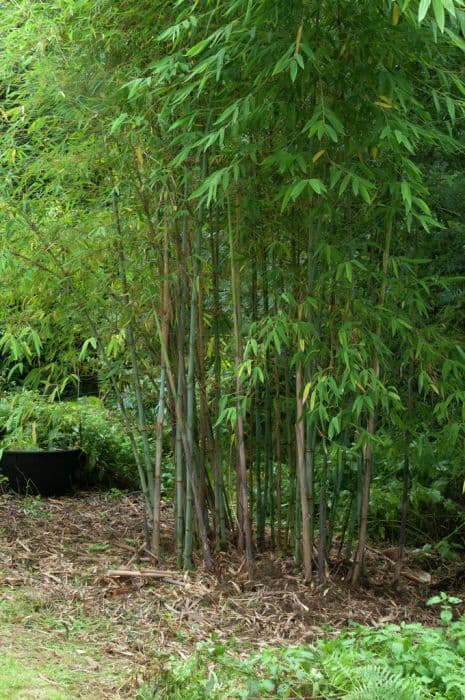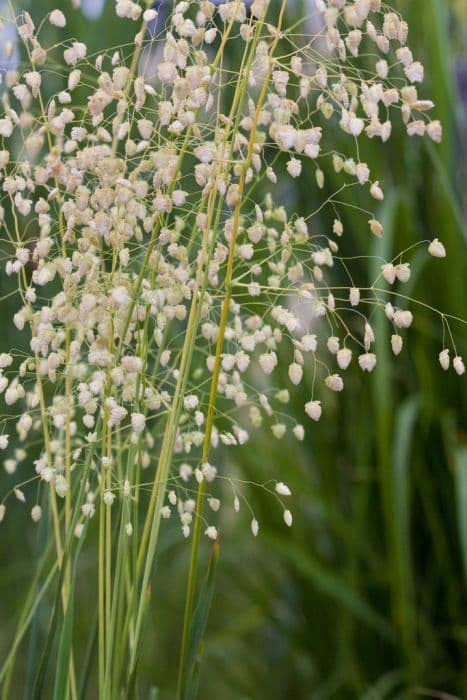Broadleaf Bamboo Sasa palmata











ABOUT
Sasa palmata is a lush, evergreen plant commonly known as broadleaf bamboo or palmate bamboo. It is characterized by its broad, paddle-shaped leaves which impart a tropical look to the foliage. These leaves are glossy and rich green in color, providing a dense and attractive appearance throughout the year. The margin of each leaf is lined with fine serrations, further distinguishing its form. The plant sports a vigorous habit, spreading via underground rhizomes that contribute to its lush spread, albeit without specific mention of its dimensions. The stems of broadleaf bamboo are sturdy and may be either upright or leaning, depending on their environment and growing conditions. The foliage on Sasa palmata provides a striking visual contrast when set against other plants, especially those with narrow or delicate leaves, making it a favored option for creating texture variances in gardens and landscapes. Its attractive appearance and hardy nature make it ideal for use as undergrowth or as a background plant in a variety of settings. Despite its robustness and tropical appearance, the specific dimensional growth, which cannot be mentioned, is an important factor to consider when incorporating Sasa palmata into any garden design.
About this plant
 Names
NamesFamily
Poaceae.
Synonyms
Broadleaf Bamboo, Palmata Bamboo, Broad-Leaved Bamboo, Palm Bamboo.
Common names
Arundinaria palmata, Bambusa palmata.
 Toxicity
ToxicityTo humans
Sasa palmata, commonly known as broadleaf bamboo, does not have a widespread reputation for being toxic to humans; it is not commonly listed among poisonous plants. Despite this, it is generally not advisable to ingest plants that are not proven to be edible, as they may cause stomach discomfort or other non-specific digestive issues. There is no well-documented case of toxicity leading to severe poisoning in humans by this particular bamboo species. Consumption of any part of broadleaf bamboo is unlikely to cause significant symptoms, but as a precaution, ingesting it should be avoided unless deemed safe by a qualified expert.
To pets
Broadleaf bamboo is not commonly known to be toxic to pets. There is no widespread or well-documented evidence that Sasa palmata causes poisoning in animals such as cats and dogs. Therefore, if a pet ingests part of this plant, significant toxic symptoms are not typically expected. However, as with any non-food plant, consumption can potentially lead to mild stomach upset or an allergic reaction in some pets, so it is advisable to discourage pets from eating broadleaf bamboo and to monitor them for any signs of discomfort if ingestion occurs. Always consult with a veterinarian if you observe adverse reactions in your pet after consuming any plant material.
 Characteristics
CharacteristicsLife cycle
Perennials
Foliage type
Evergreen
Color of leaves
Green
Height
6 feet (1.8 meters)
Spread
8 feet (2.4 meters)
Plant type
Shrub
Hardiness zones
6
Native area
Japan
Benefits
 General Benefits
General Benefits- Landscape Decoration: Sasa palmata, also known as broadleaf bamboo, can be used for ornamental purposes due to its lush, green foliage and exotic appearance.
- Ground Cover: Its dense growth habit makes it an excellent choice for ground cover, helping to suppress weeds and reduce soil erosion.
- Privacy Screen: When planted in rows, broadleaf bamboo can form a thick, tall privacy screen that blocks unwanted views and reduces noise pollution.
- Habitat for Wildlife: The plant provides shelter and food for a variety of wildlife, like birds and insects, contributing to biodiversity in the garden.
- Erosion Control: The rhizome systems of Sasa palmata help stabilize soil on slopes, preventing erosion and aiding in hillside landscape management.
- Easy Maintenance: Broadleaf bamboo is relatively low-maintenance once established, requiring minimal care compared to other garden plants.
- Fast Growth: It is known for its rapid growth rate, which makes it a quick solution for filling empty spaces in the landscape.
- Adaptability: Sasa palmata can tolerate a range of soil conditions and partial shade, making it versatile for different garden settings.
 Medical Properties
Medical PropertiesThis plant is not used for medical purposes.
 Air-purifying Qualities
Air-purifying QualitiesThis plant is not specifically known for air purifying qualities.
 Other Uses
Other Uses- Sasa palmata leaves can be used as a natural wrapping material for food, such as rice and fish, providing a unique flavor and preserving freshness.
- The canes of Sasa palmata may be utilized in the construction of light structures or garden fences, offering a rustic aesthetic and eco-friendly option.
- Fiber extracted from the plant can be woven into hats, mats, or other traditional craft items, showcasing cultural artistry and sustainable use of resources.
- The thick growth habit of Sasa palmata provides effective ground cover, reducing soil erosion and helping to maintain soil health in gardens and landscapes.
- The large leaves of Sasa palmata can be used in floral arrangements or as a natural decorative element in various traditional ceremonies and festivals.
- When dried, the leaves can serve as an insulating material or as thatch for roofing in certain types of traditional and eco-friendly constructions.
- Young shoots of Sasa palmata may be used as fodder for some farm animals, providing them with nutritional variety in their diet.
- The dense growth of Sasa palmata can be employed as a privacy screen or to create secluded spaces within larger gardens or parks.
- Crushed and soaked canes of Sasa palmata can be used in the process of water filtration, as the fibers may help to trap impurities.
- The plant's strong root system makes it suitable for stabilizing riverbanks and preventing the washing away of soil during heavy rains or floods.
Interesting Facts
 Feng Shui
Feng ShuiThe plant Sasa palmata, commonly known as broadleaf bamboo, is not traditionally used in Feng Shui practice.
 Zodiac Sign Compitability
Zodiac Sign CompitabilityThe plant Sasa palmata is not used in astrology practice.
 Plant Symbolism
Plant Symbolism- Resilience: Sasa palmata, also known as Broadleaf bamboo, is known to symbolize resilience due to its ability to quickly spread and dominate an area, often bouncing back strongly after being cut back.
- Adaptability: As a plant that can thrive in various soil conditions and climates, Broadleaf bamboo represents the ability to adapt and flourish in different environments.
- Protection: In Japan, bamboo plants are often associated with protection due to their strong and dense growth habit. Sasa palmata, with its broad leaves and sturdy growth, embodies this symbolism of providing shelter and safety.
- Growth and Prosperity: Like other bamboos, Sasa palmata is a symbol of continuous growth and prosperity, which refers to the plant's vigorous growth patterns and its constant green color throughout the seasons.
 Water
WaterThe broadleaf bamboo prefers consistent moisture, so you should water it when the top inch of the soil feels dry. This typically works out to watering approximately once a week, though this can vary depending on light and temperature conditions. When watering, use enough water to moisten the soil thoroughly, which could be around 1-2 gallons for a medium-sized pot. Avoid letting the plant sit in standing water, and in the winter, reduce watering to prevent soggy soil which can lead to root rot.
 Light
LightBroadleaf bamboo thrives in bright, indirect light but can tolerate some direct sun in cooler climates. The ideal spot would be in a room with east or west-facing windows, offering plenty of light without the intense midday sun. Avoid placing it in full shade, as this can stunt growth and reduce the plant's vigor.
 Temperature
TemperatureBroadleaf bamboo prefers moderate temperatures, ideally between 60°F and 80°F. It can tolerate a minimum temperature of around 50°F, but cold drafts and sudden temperature drops should be avoided. The plant's maximum temperature tolerance is about 90°F, but ensure it's not in direct, hot sun, as this can cause leaf scorch.
 Pruning
PruningBroadleaf bamboo benefits from pruning to manage its size, shape, and to remove any dead or yellowing leaves. The best time to prune is in the spring before new growth begins. Pruning can be done annually or as needed when the plant appears to become too dense or to encourage more compact growth.
 Cleaning
CleaningAs needed
 Soil
SoilThe Broadleaf Bamboo prefers a soil mix that is well-draining and rich in organic matter, with a pH range of 5.5 to 6.5. A mixture of two parts peat, one part perlite, and one part compost is ideal to ensure sufficient drainage and fertility.
 Repotting
RepottingBroadleaf Bamboo should be repotted every two to three years to refresh the soil and accommodate its growth. They may need more frequent repotting if they outgrow their pots or the soil becomes compacted.
 Humidity & Misting
Humidity & MistingBroadleaf Bamboo thrives in moderate to high humidity conditions, ideally between 40% and 60%. They can tolerate lower humidity levels, but consistent higher humidity is beneficial for their foliage.
 Suitable locations
Suitable locationsIndoor
Place in bright, indirect light with moist, well-draining soil.
Outdoor
Use fertile, acidic soil in a shaded or semi-shaded spot.
Hardiness zone
6-9 USDA
 Life cycle
Life cycleSasa palmata, commonly known as broadleaf bamboo or palmate bamboo, starts its life as a seed which germinates, given sufficient moisture and suitable temperature conditions. The seedling then develops a rhizome, which is an underground stem characteristic of bamboos and many grasses. Over time, the rhizome extends and from it, shoots emerge above the ground developing into canes with broad leaves. The plant matures and clumps expand through its rhizomatic growth habit. After a few years, which can vary depending on environmental conditions, the mature Sasa palmata may flower, an event that often occurs gregariously in bamboo species. Following flowering, which can often lead to the death of the individual, seeds are produced to complete the life cycle, dispersing to begin a new generation.
 Propogation
PropogationPropogation time
Spring-Early Summer
Sasa palmata, commonly known as broadleaf bamboo, can be effectively propagated by division, a popular method employed for many clumping bamboos. The best time to propagate Sasa palmata by division is in the spring as new growth emerges, which gives the plant ample time to establish itself during the growing season. To propagate by division, carefully dig up the clump of bamboo, ensuring to get as many roots as possible. Using a sharp shovel or saw, divide the clump into smaller sections, each containing several canes and a healthy amount of roots. Replant the divisions at the same depth they were growing at originally, watering well to help estabblish root growth. It is vital to maintain consistent moisture and to avoid exposing the new plants to extreme conditions while they settle in their new location.









